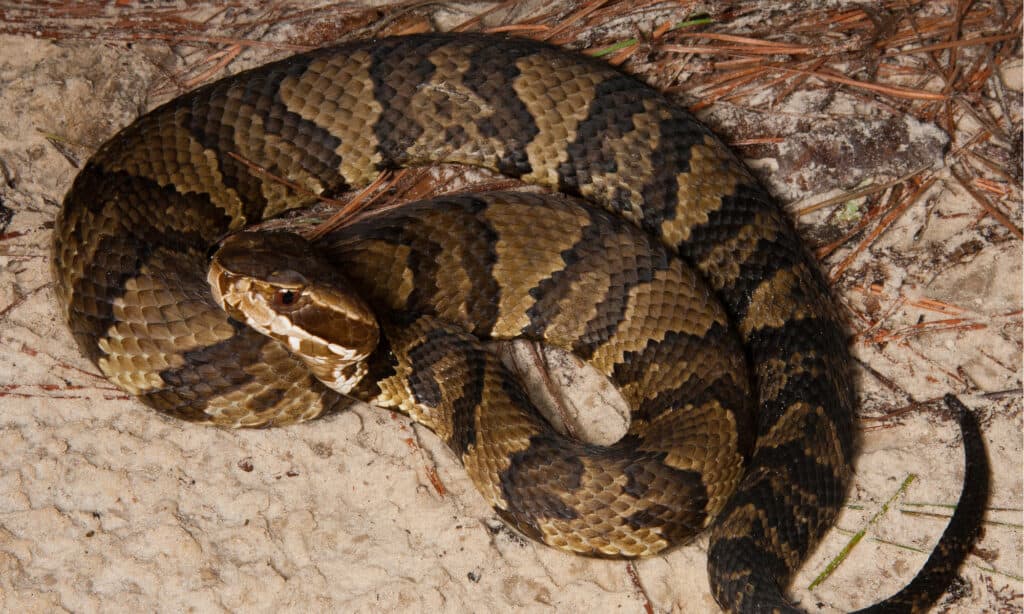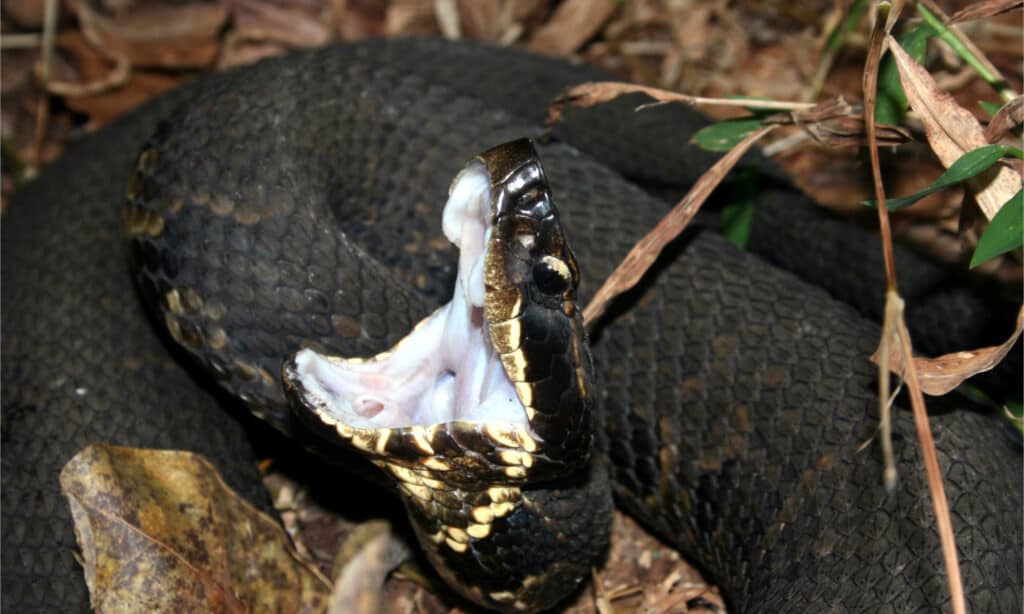Today, we will learn about different types of cottonmouth snakes. Cottonmouth snakes are venomous pit vipers that belong to the Viperidae family. They are also known as water moccasins and are semi-aquatic snakes, meaning that they dwell both on land and in water. In fact, they are one of the very few pit vipers on earth that are semi-aquatic. Cottonmouth snakes are native to the United States and usually dwell near slow-moving lakes and rivers. They are found from the southeast of the country all the way to the Midwest.
Although cottonmouth snakes are similar across the board, they are typically broken down by “territory” and have slightly different appearances and behaviors based on habitats. According to most, there are only two types of cottonmouth snakes at this time; the eastern (Florida) cottonmouth and the western cottonmouth. So, let’s learn about both!
Eastern Cottonmouth Snakes: An Overview

Eastern cottonmouths are venomous pit vipers indigenous to the southeast regions of the United States.
©Nathan A Shepard/Shutterstock.com
Also known as Florida cottonmouths, eastern cottonmouths are venomous pit vipers indigenous to the southeast regions of the United States. They are typically near the Florida Peninsula and Georgia. They are highly distributed in Florida, including the upper Keys and extreme southeastern Georgia, but spread into other parts of Georgia, southeastern Virginia, and the Carolinas. Some say the Florida cottonmouth is distinct from the eastern cottonmouth. However, their territories blend as well as their characteristics.
The eastern cottonmouth is not entirely dependent on water and is often confused with harmless water snakes that it shares the land with. This snake has hemolytic venom and can sometimes be lethal to humans, with a 17% mortality rate. Let’s learn more about this interesting pit viper!
Size and Appearance
Eastern cottonmouth snakes are moderately large and thick snakes that usually average about 2-4 feet in length. However, rarely 6-foot specimens have been found. On their head, they have black cheek strips on each side. The inside of their mouth is nearly all white, hence the name “cottonmouth.” Their body is often olive or dark brown to black with 10-17 dark bands. These bands are often darker at the edges and lighter towards the center. Young cottonmouths are typically red, and they darken with age.
Diet and Behavior
Eastern cottonmouth snakes are carnivorous and have a wide variety in their diet. They will eat anything from fish, amphibians, lizards, other snakes, turtles, birds, small mammals, and even baby alligators! Although, they will most likely be found eating fish since they hunt by and on the water.
As for their behavior, eastern cottonmouth snakes are misconstrued as aggressive snakes. However, they typically only strike when provoked or stepped on, so watch where you walk! When they defend themselves, they begin to coil up and open their mouths, displaying the white cotton-colored interior of their mouths.
Habitat and Conservation Status
Eastern cottonmouth snakes are usually found in Southeast Virginia, Florida, Georgia, and around Texas. They are found in marshes or tall grass near water such as swamps, lakes, streams, and even saltwater areas. When they hibernate, they usually do so in rock-made dens. As for conservation status, currently, eastern cottonmouth snakes are of least concern.
Western Cottonmouth Snakes: An Overview

Western cottonmouths can be found in the Midwest, near both Illinois and Indiana, as well as Tennessee and Texas.
©Psychotic Nature/Shutterstock.com
Western cottonmouths aren’t really quite different from eastern cottonmouths, except for where they are located and the appearance of their scales. They have the same white, cotton-colored mouths, and they are also just as venomous. Western cottonmouths can be found in the Midwest, near both Illinois and Indiana, as well as Tennessee and Texas. Like eastern cottonmouths, they can be found in wetlands or in marshes near freshwater. These snakes are rarely seen near saltwater because of their origin.
Size and Appearance
The western cottonmouth snake is a dark and thick-bodied snake. Its size usually ranges anywhere from 2 to 4 feet in length. The western cottonmouth is usually much darker than the eastern cottonmouth. It typically has a solid-colored body ranging anywhere from dark brown to black. It has a thick, arrow-shaped head and vertical pupils, which usually helps people distinguish it from non-venomous snakes. The belly may have a blotched scale pattern with different variations of black and brown. Like eastern cottonmouths, young western cottonmouths tend to be reddish-brown in color and darken with age.

Young cotton mouths are a reddish hue and darken as they age.
©Jay Ondreicka/Shutterstock.com
Diet and Behavior
Western cottonmouth snakes usually feed on freshwater fish. They can also eat other snakes, frogs, amphibians, small mammals, and birds because they are carnivorous. Their aggressive behavior is often greatly exaggerated. However, it is likely that they will strike if they are provoked or are stepped on. These snakes have heat sensors on their face and can track prey nearly fifty feet away. They will usually try to escape but often move in random directions when trying to flee. This may seem like they are trying to come at you rather than retreat away from you!
Habitat and Conservation Status
Western cottonmouth snakes are typically found in southern Missouri, Illinois, Indiana, Tennessee, and Central / Northern Texas. Like eastern cottonmouths, these snakes love to dwell near the water. They can typically be found in tall marshes or grass wetlands near lakes, streams, and ponds. As for their conservation status, western cottonmouths are also of least concern and are nowhere near becoming endangered currently.
How Long Do Cottonmouth Snakes Live?
While experts cannot say for sure, it is thought that cottonmouths live up to 10 years in the wild. In captivity they can live much longer, even surpassing 25 years.
Conclusion

Both types of cottonmouth are venomous and can deliver a potentially fatal bite.
©Paul S. Wolf/Shutterstock.com
Eastern and western cottonmouth snakes are fascinating pit vipers that share many similarities. It seems that their coloration and the location they live are what mainly sets them apart. Even the western cottonmouth, once considered a subspecies of cottonmouth, is now determined by DNA to be very genetically similar to the eastern cottonmouth.
Regardless of what area you are in, if you see a cottonmouth snake of any kind, they are all venomous! Therefore, please be sure when you are camping or hiking in the wild to be cautious of your surroundings. This will save you from a painful and potentially fatal bite from these very venomous pit vipers.
The photo featured at the top of this post is © Linda Burek/Shutterstock.com
Discover the "Monster" Snake 5X Bigger than an Anaconda
Every day A-Z Animals sends out some of the most incredible facts in the world from our free newsletter. Want to discover the 10 most beautiful snakes in the world, a "snake island" where you're never more than 3 feet from danger, or a "monster" snake 5X larger than an anaconda? Then sign up right now and you'll start receiving our daily newsletter absolutely free.
Thank you for reading! Have some feedback for us? Contact the AZ Animals editorial team.






